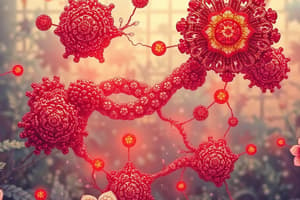Podcast
Questions and Answers
What is the primary role of enzymes in chemical reactions?
What is the primary role of enzymes in chemical reactions?
- To lower the activation energy (correct)
- To alter the reactants involved in the reaction
- To change the products of the reaction
- To increase the overall energy of the reaction
How do cofactors assist enzymes?
How do cofactors assist enzymes?
- They alter the structure of the enzyme during the reaction
- They provide the energy needed for the reaction
- They directly participate in the reaction as products
- They help the enzyme maintain its three-dimensional shape (correct)
Which model describes the enzyme's shape changing to fit the substrate?
Which model describes the enzyme's shape changing to fit the substrate?
- Enzyme-substrate model
- Lock and key model
- Conformational change model
- Induced fit model (correct)
What is formed when an enzyme binds with its substrate?
What is formed when an enzyme binds with its substrate?
What happens to an enzyme after it catalyzes a reaction?
What happens to an enzyme after it catalyzes a reaction?
What characterizes the active site of an enzyme?
What characterizes the active site of an enzyme?
What best describes the role of lactase in the human body?
What best describes the role of lactase in the human body?
What is the primary role of enzymes in biochemical reactions?
What is the primary role of enzymes in biochemical reactions?
How do enzymes reduce the activation energy of a reaction?
How do enzymes reduce the activation energy of a reaction?
Which of the following factors does NOT influence the rate of a biochemical reaction?
Which of the following factors does NOT influence the rate of a biochemical reaction?
What is the consequence if a catalyst were not present for certain biochemical reactions?
What is the consequence if a catalyst were not present for certain biochemical reactions?
What characteristic of enzymes allows them to be effective catalysts?
What characteristic of enzymes allows them to be effective catalysts?
Which statement accurately reflects the relationship between enzymes and energy?
Which statement accurately reflects the relationship between enzymes and energy?
Which of the following is NOT a factor that influences the speed of a biochemical reaction?
Which of the following is NOT a factor that influences the speed of a biochemical reaction?
What important function do enzymes fulfill for living organisms?
What important function do enzymes fulfill for living organisms?
Flashcards are hidden until you start studying
Study Notes
Enzyme Function
- Enzymes are biological catalysts that accelerate biochemical reactions.
- Without enzymes, many reactions would take millions of years.
- Enzymes reduce reaction times to milliseconds.
- They are crucial for sustaining life's biological functions (growth, reproduction, homeostasis).
- Enzymes increase reaction rates to biologically relevant levels.
- Enzymes lower activation energy, the minimum energy required for a reaction to occur spontaneously.
- Enzymes don't alter the overall energy (Gibbs free energy) of a reaction; they only lower the activation energy needed to start it.
Enzyme Mechanism
- Enzymes function by bringing reactants (substrates) together for efficient interaction.
- The main function of enzymes is to lower activation energy, enabling reactions to proceed at life-sustaining rates.
- Some enzymes require cofactors (ions, vitamins, or organic groups) to function properly. These cofactors help maintain the enzyme's 3D shape and substrate binding.
- Enzyme function involves four steps: substrate and enzyme availability, binding at the active site forming an enzyme-substrate complex, product formation, and product release.
- Enzymes are not changed during the reaction, allowing them to catalyze multiple reactions.
Enzyme Structure and Active Site
- Enzymes are proteins with a specific 3D tertiary structure.
- The active site is the region where the substrate binds to the enzyme.
- Substrate binding induces a conformational change in the enzyme, facilitating product formation.
- Lactase, which breaks down lactose (milk sugar) into glucose and galactose is an example of an enzyme in humans
- The active site facilitates the conversion of substrate to product.
- Two models describe substrate-enzyme interaction: induced fit (enzyme changes shape to bind substrate) and lock and key (substrate fits directly into the enzyme).
Studying That Suits You
Use AI to generate personalized quizzes and flashcards to suit your learning preferences.





